Western Belorussia
Western Belorussia or Western Belarus (Belarusian: Заходняя Беларусь, romanized: Zachodniaja Bielaruś; Polish: Zachodnia Białoruś; Russian: Западная Белоруссия, romanized: Zapadnaya Belorussiya) is a historical region of modern-day Belarus which belonged to the Second Polish Republic during the interwar period. For twenty years before the 1939 invasion of Poland, it was the northern part of the Polish Kresy macroregion.[1] Following the end of World War II in Europe, most of Western Belorussia was ceded to the Soviet Union by the Allies, while some of it, including Białystok, was given to the Polish People's Republic. Until the dissolution of the Soviet Union in 1991, Western Belorussia formed the western part of the Byelorussian Soviet Socialist Republic (BSSR). Today, it constitutes the west of modern Belarus.[2]
Western Belarus | |
|---|---|
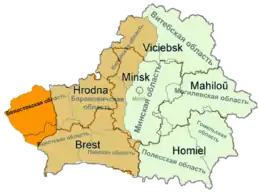 Administrative division of the Byelorussian SSR (green) before World War II with territories annexed by the USSR from Poland in 1939 (marked in shades of orange), overlaid with territory of present-day Belarus | |
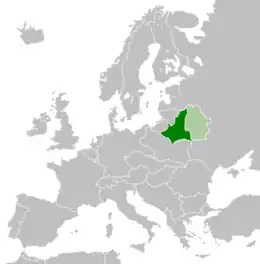 Western Belorussia in 1925 shown in dark green and the Byelorussian Soviet Socialist Republic shown in light green | |
| Country | Belarus, partly in Poland and Lithuania |
| Area | Historical region |
| Today part of | Grodno, Brest, Minsk (partially) and Vitsebsk (partially); Podlaskie Voivodeship (partially), Southeastern Lithuania including Vilnius |
Created by the USSR after the conquest of Poland, the new western provinces of Byelorussian SSR acquired from Poland included Baranavichy, Belastok, Brest, Vileyka and the Pinsk Regions.[3] They were reorganized one more time after the Soviet liberation of Belarus into the contemporary western provinces of Belarus which include all of Grodno and Brest regions, as well as parts of today's Minsk and Vitebsk regions. Vilnius[4][5] was returned by the USSR to the Republic of Lithuania which soon after that became the Lithuanian SSR.[6]
Background
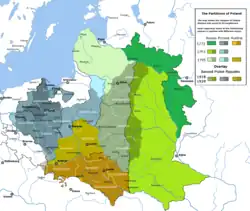
The territories of contemporary Belarus, Poland, Ukraine, and the Baltic states were a major theatre of operations during World War I; all the while, the Bolshevik Coup overturned the interim Russian Provisional Government and formed Soviet Russia. The Bolsheviks withdrew from the war with the Central Powers by signing the Treaty of Brest-Litovsk,[7] and ceded Belarus to Germany for the next eight and a half months. The German high command used this window of opportunity to transfer its troops to the Western Front for the 1918 Spring Offensive, leaving behind a power vacuum.[8] The non-Russians inhabiting the lands ceded by the Soviets to the German Empire, saw the treaty as an opportunity to set up independent states under the German umbrella. Three weeks after the Treaty of Brest-Litovsk was signed on 3 March 1918, the newly formed Belarusian Central Council founded the Belarusian People's Republic. The idea was rejected by the Germans, the Bolsheviks and the Americans. Woodrow Wilson rejected it, because the Americans intended to protect the territorial integrity of European Russia.[7]
The fate of the region was not settled for the following three and a half years. The Polish–Soviet War which erupted in 1919, was particularly bitter; it ended with the Peace of Riga of 1921.[1] Poland and the Baltic states emerged as independent countries bordering the USSR. The territory of modern-day Belarus was split by the treaty into Western Belorussia ruled by the Polish and the Soviet Eastern Belorussia, with the border town in Mikaszewicze.[9][10] Notably, the peace treaty was signed with the full active participation of the Belarusian delegation on the Soviet side.[11] In paragraph 3, Poland abandoned all rights and claims to the territories of Soviet Belarus, while Soviet Russia abandoned all rights and claims to Polish Western Belarus.[11]
Rada of the Belarusian Democratic Republic in Exile
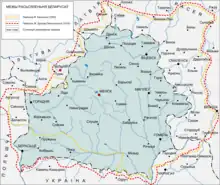
As soon as the Soviet-German peace treaty was signed in March 1918, the newly formed Rada of the Belarusian Democratic Republic laid territorial claims to Belarus based on areas specified in the Third Constituent Charter unilaterally as inhabited by the Belarusian majority. The same Rada charter also declared that the Treaty of Brest-Litowsk of March 1918 was invalid because it was signed by foreign governments partitioning territories that were not theirs.[12]
In February 1919, a joint Lithuanian Belorussian Soviet Republic (Litbel) was established, and then a separate Byelorussian SSR. Thus, the almost unsolicited national state, which arose during the First World War, owed its existence directly to the alternative German, Russian and Polish attempts to secure control over the area. — Tania Raffass [13]
In the Second Constituent Charter, the Rada abolished the right to private ownership of land (paragraph 7) in line with the Communist Manifesto.[12] Meanwhile, by 1919, the Bolsheviks took control over large parts of Belarus and forced the Belarusian Rada into exile in Germany. The Bolsheviks formed the Socialist Soviet Republic of Byelorussia during the war with Poland on roughly the same territory claimed by the Belarusian Republic.[14]
The League of Nations ratified the new Polish-Soviet border.[1] The peace agreement remained in place throughout the interwar period. The borders established between the two countries remained in force until World War II and the 17 September 1939 Soviet invasion of Poland. On Joseph Stalin's insistence, the borders were redrawn in the Yalta and Potsdam Conferences.[1]
Second Polish Republic
"Despite Soviet efforts at sealing the border [with Poland], peasants – refugees from the BSSR – crossed into Poland in the tens of thousands, wrote Per Anders Rudling.[15] According to the Polish census of 1921, there were around 1 million Belarusians in the country. Some estimated the number of Belarusians in Poland at that time to be perhaps 1.7 million,[16] or even up to 2 million.[17] Following the Peace of Riga, thousands of Poles settled in the area, many of them (including veterans of armed struggle for Poland's independence) were given land by the government.[18]
In his negotiations with Belarusian leaders in Vilnius, Józef Piłsudski rejected the call for Western Belorussian independence. In December 1919 the Rada was dissolved by Poland, while by early January 1920 a new body was formed, the Rada Najwyższa, without aspirations for independence, but with proposed cultural, social and educational functions.[19] Józef Piłsudski negotiated with the Western Belorussian leadership,[20] but eventually abandoned the ideas of Intermarium, his own proposed federation of partially self-governing states on the lands of the former Polish–Lithuanian Commonwealth.[21]
In the 1922 Polish legislative election, the Belarusian party in the Bloc of National Minorities obtained 14 seats in the Polish parliament (11 of them in the Sejm).[22] In the spring of 1923, Polish prime minister Władysław Sikorski ordered a report on the situation of the Belarusian minority in Poland. That summer, a new regulation was passed allowing for the Belarusian language to officially be used in courts and schools. Obligatory teaching of the Belarusian language was introduced in all Polish gymnasia in areas inhabited by Belarusians in 1927.[22]
Polonization
The Belarusian population of West Belarus faced active Polonization by the central Polish authorities. The policy pressured Belarusian schooling, discriminated against the Belarusian language, and imposed the Polish national identity on Roman Catholics in Belarus.
In January 1921, the starosta from Wilejka wrote of the popular mood as being one of resignation and apathy among the Western Belorussian peasants, impoverished by food requisitions by the Bolsheviks and the Polish military. He insisted that, although the new Belarusian schools were 'springing up everywhere' in his county, they harbored anti-Polish attitudes.[23]
In 1928 there were 69 schools with Belarusian language in Western Belorussia; the attendance was minimal due in part to lower quality of instruction.[24] The first-ever textbook of Belarusian grammar was written only around 1918.[25] In 1939, over 90% of children in Poland attended school.[26] As elsewhere, the educational systems promoted Polish language there also.[27] Meanwhile, the Belarusian agitators deported to the USSR from Poland were put in prison by the Soviet NKVD as bourgeois nationalists.[28]
Most Polish inhabitants of the region supported the policy of cultural assimilation of Belarusians as proposed by Dmowski.[29] The polonization drive was inspired and influenced by Dmowski's Polish National Democracy, who advocated refusing Belarusians and Ukrainians the right of free national development.[30] Władysław Studnicki, an influential Polish official, stated that Poland's engagement in the East amounts to a much needed economic colonization.[31] Belarusian nationalist media was pressured and censored by the Polish authorities.[32]
Belarusians were divided along religious lines with roughly 70% being Orthodox and 30% Roman Catholic.[25] According to Russian sources, discrimination was targeting assimilation of Eastern Orthodox Belarusians.[33] The Polish church authorities promoted Polish in Orthodox services,[33] and initiated the creation of the Polish Orthodox Societies in four cities including Slonim, Białystok, Vawkavysk, and Novogrodek.[33] The Belarusian Roman Catholic priest Fr. Vincent Hadleŭski who promoted Belarusian in church,[33] and Belarusian national awareness, was under pressure by his Polish counterparts.[33] The Polish Catholic Church in Western Belorussia issued documents to priests about the usage of the Belarusian language rather than Polish language in Churches and Catholic Sunday Schools. The Warsaw-published instruction of the Polish Catholic Church from 1921 criticized priests preaching in Belarusian at the Catholic masses.[34]
Hramada
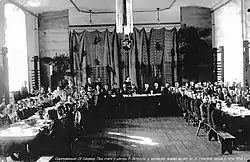
Compared to the (larger) Ukrainian minority living in Poland, Belarusians were much less politically aware and active. The largest Belarusian political organization was the Belarusian Peasants' and Workers' Union, also referred to as the Hramada. Hramada received logistical help from the Soviet Union and the Communist International and served as a cover for the radical and subversive Communist Party of Western Belorussia. It was therefore banned by the Polish authorities,[35][36] its leaders sentenced to various terms in prison and then deported to the USSR, where they were killed by the Soviet regime.[37]
Tensions between the increasingly nationalistic Polish government and various increasingly separatist ethnic minorities continued to grow, and the Belarusian minority was no exception. Likewise, according to Marek Jan Chodakiewicz, the USSR considered Poland to be "enemy number one".[38] During the Great Purge, the Polish National District at Dzyarzhynsk was disbanded and the Soviet NKVD undertook the so-called "Polish Operation" (from approximately August 25, 1937, to November 15, 1938) – where the Poles in East Belorussia, i.e. BSSR, were deported and executed.[38] The operation caused the deaths of up to 250,000 people – out of an official ethnic Polish population of 636,000 – as a result of political murder, disease or starvation.[38] Amongst these, at least 111,091 members of the Polish minority were shot by NKVD troika.[38][39][40] According to Bogdan Musiał, many were murdered in prison executions.[39] In addition, several hundred thousand ethnic Poles from Belarus and Ukraine were deported to other parts of the Soviet Union.[38]
The Soviets also promoted the Soviet-controlled BSSR as formally autonomous to attract Belarusians living in Poland. This image was attractive to many Western Belorussian national leaders, and some of them, like Frantsishak Alyakhnovich or Uładzimir Žyłka emigrated from Poland to the BSSR, but very soon became victims of Soviet repression.
Soviet invasion of Poland, 1939

Soon after the Nazi-Soviet invasion of Poland following the Nazi–Soviet Pact, the area of Western Belorussia was formally annexed into the Belarusian Soviet Socialist Republic (BSSR). The Soviet secret police NKVD, aided by the Red Army, organized staged elections which were decided in the atmosphere of intimidation and state terror.[41] The Soviet occupational administration held the elections on October 22, 1939, less than two weeks after the invasion.[42] The citizens were threatened repeatedly that their deportations to Siberia were imminent. The ballot envelopes were numbered to remain traceable and usually handed over already sealed.[41] The referendum was rigged. By design, the candidates were unknown to their constituencies which were brought to the voting stations by armed guards.[43] The so-called Elections to the People's Assemblies of Western Ukraine and Western Belorussia were conducted in Russian.[41]
On October 30, the People's Assembly session held in Belastok (Polish Białystok) affirmed the Soviet decision to join the Belarusian Soviet Socialist Republic (BSSR) with the USSR. The petition was officially accepted by the Supreme Soviet of the USSR on November 2 and by the Supreme Soviet of the BSSR on November 12, 1939.[44] From then on, all citizens of Poland but also born in Poland would find themselves living in the Byelorussian SSR as the Soviet subjects, without the recognition of their Polish citizenship.[45]
The Soviet propaganda portrayed the Soviet invasion of Poland as the "reunion of Western Belorussia and Ukraine". Many ethnic Belarusians and Jews welcomed unification with the BSSR. Mostly wealthy groups of citizens changed their attitude after experiencing firsthand the style of the Soviet system.[45][46]
Deportations, arrests, and the reign of terror
.jpg.webp)
The Soviets quickly began confiscating, nationalizing, and redistributing all private and state-owned property.[47] During the two years following the annexation, the Soviets arrested approximately 100,000 Polish citizens across Kresy.[48] Due to a lack of access to the secret Soviet and Belarusian archives, for many years after the war the estimates of the number of Polish citizens deported to Siberia from the areas of Western Belorussia, as well as the number who perished under Soviet rule, were only estimated.[49] In August 2009, on the occasion of the 70th anniversary of the Soviet invasion, the authoritative Polish Institute of National Remembrance announced that its researchers reduced the estimate of the number of people deported to Siberia to 320,000 in total. Some 150,000 Polish citizens perished under Soviet rule.[50]
The Soviet–German War 1941–1945
The terms of the Molotov–Ribbentrop Pact signed earlier in Moscow were soon broken, when the German Army entered the Soviet occupation zone on June 22, 1941. After Operation Barbarossa, most of Western Belorussia became part of the German Reichskommissariat Ostland (RKO), as the so-called Generalbezirk Weißruthenien (General Region of White Ruthenia). Many ethnic Belarusians supported Nazi Germany.[51] By the end of 1942, sworn Germanophile Ivan Yermachenka formed the pro-Nazi BNS organization with 30,000 members.[52] The Belarusian Auxiliary Police was formed.[52][53] Known to the Germans as the Schutzmannschaft, the ethnic Belarusian police played an indispensable role in the Holocaust in Belarus,[54][55] notably during the second wave of the ghetto liquidations,[56] starting in February–March 1942.[53]
In 1945, the Big Three, Great Britain, the United States and the Soviet Union, established new borders for Poland. Most of Western Belarus remained part of the BSSR after the end of World War II in Europe; only the region around Białystok (Belostok) was to be returned to Poland. The Polish population was soon forcibly resettled west. The Western Belorussia, in its entirety, was incorporated into the BSSR.[2]
It was initially planned to move the capital of the BSSR to Vilna. However, the same year Joseph Stalin ordered that the city and surrounding region be transferred to Lithuania, which some months later was annexed by the Soviet Union and became a new Soviet Republic. Minsk, therefore, remained the capital of the enlarged BSSR. The borders of the BSSR were again altered somewhat after the war (notably the area around the city of Białystok (Belastok Region) was returned to Poland). Still, in general, they coincide with the borders of the modern Republic of Belarus.
Sovietization
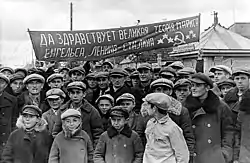
The Belarusian political parties and the society in Western Belorussia often lacked information about repressions in the Soviet Union and was under a strong influence of Soviet propaganda.[33] Because of bad economic conditions and national discrimination of Belarusian in Poland, much of the population of Western Belorussia welcomed the annexation by the USSR.[33]
However, soon after the annexation of Western Belorussia by the Soviet Union, the Belarusian political activists had no illusions as to the friendliness of the Soviet regime.[33] The population grew less loyal as the economic conditions became even worse and as the new regime carried out mass repressions and deportations that targeted Belarusians as well as ethnic Poles.[33]
Immediately after the annexation, the Soviet authorities carried out the nationalization of agricultural land owned by large landowners in Western Belorussia.[33] Collectivization and the creation of collective farms (kolkhoz) was planned to be carried out at a slower pace than in Eastern Belorussia in the 1920s.[33] By 1941, in the western regions of the BSSR, the number of individual farms decreased only by 7%; 1115 collective farms were created.[33] At the same time, pressure and even repressions against larger farmers (called by the Soviet propaganda, kulaki) began: the size of agricultural land for one individual farm was limited to 10ha, 12ha and 14ha depending on the quality of the land.[33] It was forbidden to hire workers and lease land.[33]
Under the Soviet occupation, the Western Belorussian citizenry, particularly the Poles, faced a "filtration" procedure by the NKVD apparatus, which resulted in over 100,000 people being forcibly deported to eastern parts of the Soviet Union (e.g. Siberia) in the very first wave of expulsions.[58] In total, during the next two years some 1.7 million Polish citizens were put on freight trains and sent from the Polish Kresy to labour camps in the Gulag.[59]
Republic of Belarus
The majority of Poles live in the Western regions, including 230,000 in the Grodno oblast. In addition, Sapotskin and its selsoviet have a Polish majority. The largest Polish organization in Belarus is the Union of Poles in Belarus (Związek Polaków na Białorusi), with over 20,000 members.
Notes
- Anna M. Cienciala (2004). "The Rebirth of Poland". History 557: Poland and Soviet Russia: 1917-1921. The Bolshevik Revolution, the Polish-Soviet War, and the Establishment of the Polish-soviet Frontier. University of Kansas (Lecture Notes 11 B). Archived from the original on 2012-02-05. Retrieved 31 July 2016 – via Internet Archive.
- Piotr Eberhardt; Jan Owsinski (2003). Ethnic Groups and Population Changes in Twentieth-century Central-Eastern Europe: History, Data, Analysis. M.E. Sharpe. pp. 199–201. ISBN 978-0-7656-0665-5.
- Александр Локотко; Ольга Князева; Евгений Морозов; Ольга Изотова (2017). Mosaic of Belarus. Litres. p. 425. ISBN 978-5457636637.
- Algimantas P. Gureckas, Lithuania's Boundaries and Territorial Claims between Lithuania and Neighboring States, New York Law School Journal of International and Comparative Law, New York Law School, New York, 1991, Vol.12, Numbers 1 & 2, p. 126-128.
- Marjorie M. Whiteman, ed., Digest of International Law, Department of State Publication 7737, Washington, DC, 1964, Vol.3, p. 185-186 & 190.
- Ronen, Yaël (2011). Transition from Illegal Regimes Under International Law. Cambridge University Press. p. 17. ISBN 978-0-521-19777-9.
- Ruth Fischer (2006) [1948]. Stalin and German Communism. Transaction Publishers. pp. 32, 33–36. ISBN 1412835011.
- Smithsonian (2014). World War I: The Definitive Visual History. Penguin. p. 227. ISBN 978-1465434906.
- Adam Daniel Rotfeld; Anatoly V. Torkunov (2015). White Spots—Black Spots: Difficult Matters in Polish-Russian Relations, 1918–2008. University of Pittsburgh Press. p. 64. ISBN 978-0822980957.
- Janusz Cisek (2002). Kosciuszko, We Are Here!: American Pilots of the Kosciuszko Squadron in Defense of Poland, 1919-1921. McFarland. p. 91. ISBN 0786412402.
- Michael Palij (1995). The Ukrainian-Polish Defensive Alliance, 1919-1921: An Aspect of the Ukrainian Revolution. CIUS Press. p. 165. ISBN 1895571057.
- Executive Committee; Ivonka J. Survilla (9 March 1918). "Council of BNR". Rada of the Belarusian Democratic Republic in Exile. First, Second, and Third Constituent Charter.
Mensk, 21 (8) February 1917 – 25 March 1918
- Tania Raffass (2012). "The roots of the Soviet Federation". The Soviet Union: Federation Or Empire?. Routledge Studies in the History of Russia and Eastern Europe. p. 44. ISBN 978-0415688338.
- Map of the Soviet Socialist Republic of Belarus on JiveBelarus.net website.
- Rudling 2014, p. 206.
- Żarnowski, p. 373.
- Mironowicz 1999, p. 80.
- Alice Teichova; Herbert Matis; Jaroslav Pátek (2000). Economic Change and the National Question in Twentieth-century Europe. Cambridge University Press. ISBN 978-0-521-63037-5.
- Mironowicz 2007, p. 34, "Białoruska reprezentacja narodowa stojąca na gruncie niepodległości była nie do zaakceptowania przez stronę polską. Rada została rozwiązana w grudniu 1919 r. przez Raczkiewicza na osobisty rozkaz Piłsudskiego. W jej miejsce powołano na początku 1920 r. Białoruską Radę Najwyższą aspirującą wprawdzie do roli reprezentacji narodowej, lecz bez podnoszenia problemu państwowości białoruskiej."
- Mironowicz 2007, p. 33
- Mironowicz 2007, p. 34
- Mironowicz 1999, p. 94.
- Mironowicz 2007, pp. 37–38, [Starosta] "ze stycznia 1921r. mówił o nastrojach miejscowego społeczeństwa: »zupełna rezygnacja i apatia ludności wiejskiej doprowadzonej do zupełnej nędzy przez bolszewików i wojsko polskie ciągłymi rekwizycjami.« Cały powiat pokrył się siecią szkół białoruskich ... zapewniał jednak, że szkoły białoruskie mają antypaństwowy charakter."
- Mironowicz 2007, p. 72, "W najpomyślniejszym dla szkolnictwa białoruskiego roku 1928 istniało w Polsce 69 szkół w których nauczano języka białoruskiego."
- Rudling 2015, p. 120 (6 of 13 in PDF).
- Norman Davies (2005). God's Playground. A History of Poland, Vol. II: 1795 to the Present. Oxford University Press. p. 175. ISBN 0199253390.
- Mironowicz 2007, pp. 41, 53–54
- Mironowicz 2007, p. 93, W Białorusi Radzieckiej ... aresztowano byłych przywódców Hromady, którzy po opuszczeniu więzień w Polsce zostali przekazani władzom radzieckim w ramach wymiany więźniów politycznych.[224]
- Mironowicz 2007, p. 34, "Większość Polaków pragnęła łączyć plany nabytków terytorialnych Józefa Piłsudskiego z polityką asymilacyjną proponowaną przez Romana Dmowskiego."
- Mironowicz 2007, pp. 4–5
- Mironowicz 2007, p. 12, "Zaangażowanie Polski na Białorusi i Ukrainie to ekspansja kolonialna, konieczna ze w zględów gospodarczych" (Studnicki).
- Кореневская, О. (2003). "Особенности Западнобелорусского возрождения (на примере периодической печати)" (PDF). Białoruskie Zeszyty Historyczne (20): 69–89.
- Hielahajeu, Alaksandar (17 September 2014). "8 мифов о "воссоединении" Западной и Восточной Беларуси" [8 Myths about the "reunification" of Western Belorussia and Eastern Belorussia] (in Russian). Retrieved 26 July 2016.
- Mironowicz 2007, p. 45
- Andrzej Poczobut; Joanna Klimowicz (June 2011). "Białostocki ulubieniec Stalina" (PDF file, direct download 1.79 MB). Ogólnokrajowy tygodnik SZ «Związek Polaków na Białorusi» (Association of Poles of Belarus). Głos znad Niemna (Voice of the Neman weekly), Nr 7 (60). pp. 6–7 of current document. Retrieved 24 May 2014.
- Andrew Savchenko (2009). Belarus: A Perpetual Borderland. BRILL. pp. 106–107. ISBN 978-9004174481.
- Sanko, Zmicier; Saviercanka, Ivan (2002). 150 пытаньняў і адказаў з гісторыі Беларусі [150 Questions and Answers on the History of Belarus] (in Belarusian). Vilnius: Наша Будучыня. ISBN 985-6425-20-4.
- Marek Jan Chodakiewicz, 2012, Intermarium: The Land between the Black and Baltic Seas, Transaction Publishers, pp. 81–82.
- Bogdan Musial (January 25–26, 2011). "The 'Polish operation' of the NKVD" (PDF). The Baltic and Arctic Areas under Stalin. Ethnic Minorities in the Great Soviet Terror of 1937-38. University of Stefan Wyszyński in Warsaw. pp. 17–. Retrieved April 26, 2011.
UMEA International Research Group. Abstracts of Presentations.
- O.A. Gorlanov. "A breakdown of the chronology and the punishment, NKVD Order № 00485 (Polish operation) in Google translate". Retrieved April 26, 2011.
- Wegner, Bernd (1997). From peace to war: Germany, Soviet Russia, and the world, 1939–1941. pp. 74–. ISBN 1571818820.
{{cite book}}:|work=ignored (help) - "Сборник документов «Государственные границы Беларуси»" Vol. 2, June 28, 2016 retrieved November 27, 2017.
- Jan T. Gross (1997). Sovietisation of Poland's Eastern Territories. pp. 74–75. ISBN 1571818820.
{{cite book}}:|work=ignored (help) - (in Belarusian)Уладзімір Снапкоўскі. Беларусь у геапалітыцы і дыпламатыі перыяду Другой Сусветнай вайны
- Norman Davies, God's Playground (Polish edition), second tome, p.512-513.
- (in Polish) Stosunki polsko-białoruskie pod okupacją sowiecką (1939-1941)
- Piotrowski 1998, p. 11
- "Represje 1939–41. Aresztowani na Kresach Wschodnich" [Repressions 1939–1941. Arrested in the Eastern Borderlands]. Karta (in Polish). Ośrodek KARTA Center. Archived from the original on 2006-10-21.
- Rieber 2000, pp. 14, 32–37
- "Polish experts lower nation's WWII death toll". AFP/Expatica. 2009.
- Marek Wierzbicki. "Polish-Belarusian relations under the Soviet occupation" [Stosunki polsko-białoruskie pod okupacją sowiecką (1939–1941)]. НА СТАРОНКАХ КАМУНІКАТУ. Białoruskie Zeszyty Historyczne. 20 (2003): 186–188. Archived from the original on 6 April 2009 – via Internet Archive.
- Leonid Rein (2013). The Kings And The Pawns. Berghahn Books. pp. 144–145. ISBN 978-1782380481.
- Alexey Litvin (Алексей Літвін), Participation of the local police in the extermination of Jews (Участие местной полиции в уничтожении евреев, в акциях против партизан и местного населения.); (in) Местная вспомогательная полиция на территории Беларуси, июль 1941 — июль 1944 гг. (The auxiliary police in Belarus, July 1941 - July 1944).
- Martin Dean (2003). Collaboration in the Holocaust: Crimes of the Local Police in Belorussia and Ukraine, 1941-44. Palgrave Macmillan. p. viii. ISBN 1403963711.
- Andrea Simon (2002). Bashert: A Granddaughter's Holocaust Quest. p. 225. ISBN 1578064813.
{{cite book}}:|work=ignored (help) - Andrea Simon (2002). Bashert: A Granddaughter's Holocaust Quest. Univ. Press of Mississippi. p. 228. ISBN 1578064813.
- (in Polish) Marek Wierzbicki, Stosunki polsko-białoruskie pod okupacją sowiecką (1939–1941). "Białoruskie Zeszyty Historyczne" (НА СТАРОНКАХ КАМУНІКАТУ, Biełaruski histaryczny zbornik) 20 (2003), p. 186–188. Retrieved 16 July 2007.
- (in Belarusian) Сёньня — дзень ўзьяднаньня Заходняй і Усходняй Беларусі
- A Forgotten Odyssey 2001 Lest We Forget Productions.
References
- Budreckis, Algirdas (1967). "ETNOGRAFINĖS LIETUVOS RYTINĖS IR PIETINĖS SIENOS". Karys.
- Hesch, Michael (1933). Letten, Litauer, Weissrussen (in German). Wien.
{{cite book}}: CS1 maint: location missing publisher (link) - Mironowicz, Eugeniusz (1999). Białoruś (in Polish). Warszawa: Trio. ISBN 83-85660-82-8.
- Mironowicz, Eugeniusz (2007). Belarusians and Ukrainians in the policies of the Piłsudski camp [Białorusini i Ukraińcy w polityce obozu piłsudczykowskiego] (in Polish). Białystok: Wydawnictwo Uniwersyteckie Trans Humana. 'Preface' (pp. 3–31), chpt. 1 (pp. 32–94), chpt. 2 (pp. 95–178), chpt. 3 (pp. 179–257) &c. ISBN 978-83-89190-87-1.
- Piotrowski, Tadeusz (1998). Poland's Holocaust: Ethnic Strife: Collaboration with Occupying Forces and Genocide in the Second Republic, 1918–1947. Jefferson, NC: McFarland & Company. ISBN 0-7864-0371-3.
- Rieber, Alfred Joseph (2000). Forced Migration in Central and Eastern Europe: 1939–1950. London, New York: Routledge. ISBN 0-7146-5132-X.
- Rudling, Per Anders (2014). The Rise and Fall of Belarusian Nationalism, 1906–1931. University of Pittsburgh Press. ISBN 978-0822979586.
- Rudling, Per Anders (2015). "The Beginnings of Modern Belarus: Identity, Nation, and Politics in a European Borderland" (PDF). The Journal of Belarusian Studies. Annual London Lecture on Belarusian Studies. 7 (3). pp. 115–127 (1–13 in PDF), direct download. doi:10.1163/20526512-00703008. S2CID 155122222.
- Żarnowski, Janusz (1973), Społeczeństwo Drugiej Rzeczypospolitej 1918-1939 (in Polish), Warszawa.